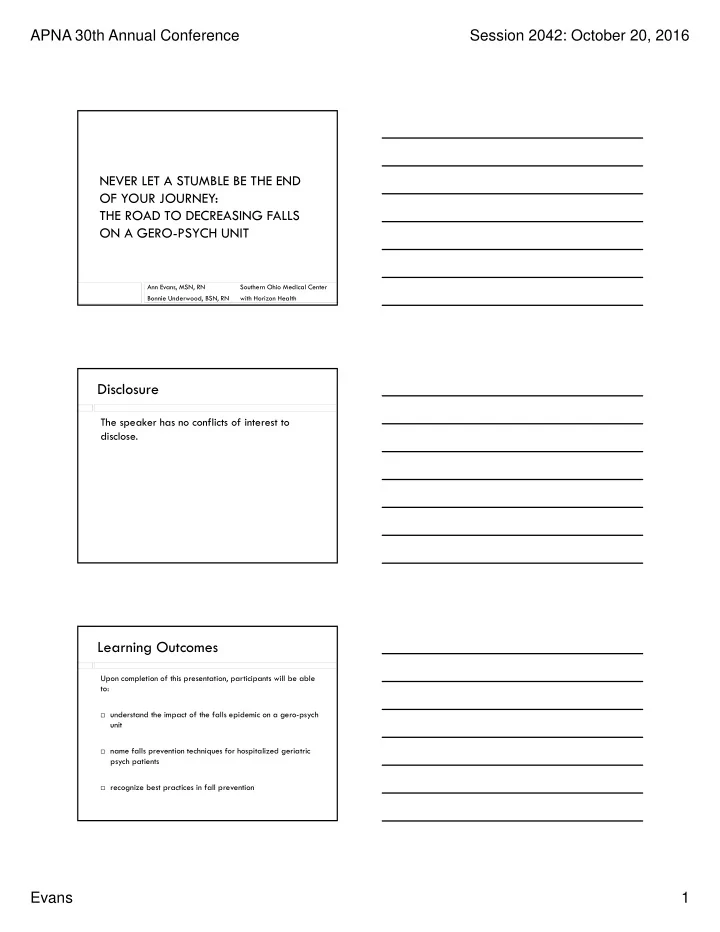

APNA 30th Annual Conference Session 2042: October 20, 2016 NEVER LET A STUMBLE BE THE END OF YOUR JOURNEY: THE ROAD TO DECREASING FALLS ON A GERO-PSYCH UNIT Ann Evans, MSN, RN Southern Ohio Medical Center Bonnie Underwood, BSN, RN with Horizon Health Disclosure The speaker has no conflicts of interest to disclose. Learning Outcomes Upon completion of this presentation, participants will be able to: understand the impact of the falls epidemic on a gero-psych unit name falls prevention techniques for hospitalized geriatric psych patients recognize best practices in fall prevention Evans 1
APNA 30th Annual Conference Session 2042: October 20, 2016 Introduction Falls continue to be a challenging patient safety issue on an inpatient geriatric psychiatry unit. 30-35% of patients who fall will sustain an injury. Falls are the leading cause of death among the hospitalized older adult. Falls with serious injury continue to be in the Top 10 sentinel events as reported to The Joint Commission. The Joint Commission, 2015 Summary of Evidence Fall rates were consistently above the National Database of Nursing Quality Indicators (NDNQI) benchmark of 9 or less falls per 1000 patient days. The fall rates on this geriatric psych unit was 20.3 in fiscal year 2013, 17.2 in fiscal year 2014, and 14.1 in fiscal year 2015. The falls rate continued to be significantly higher than the NDNQI benchmark at the beginning of fiscal year 2016, with a rate of 14.8 . Trend in Fall Rates SBMCU Fall Rate (Before New Interventions) 25 20 15 Fall Rate 10 5 0 FY 2013 FY 2014 FY 2015 Evans 2
APNA 30th Annual Conference Session 2042: October 20, 2016 Falls Analysis Time Period - July ‘15 to Sept ‘15 Time of Fall 48% (12pm to 3pm) N =17 Falls (4 with Injury) 23% (Evening shift change) 17% (8pm-11pm) #1 Diagnosi s- Aggressive Behavior 6% (after breakfast) 6% (at supper) Where did patients fall? 35% Hall Falls with Injury : 29% Front Nurses Desk 80% (12-2pm) 29% Patient Room 40% Front of Nurses Desk 40% in Hall 6% Dining/Group Room 60% were repeat falls Timeline of New Falls Interventions November 2015 Implemented all patients will have their bed/chair alarm set, regardless of fall risk level Implemented bed/chair alarm checks with every 15 minute observation round for all patients Begin taking patients to common room between groups/meals December 2015 Go Live with the Edmonson Falls Risk Assessment on SBMCU January 2016 Change treatment team time to 9:30 am February 2016 Assign staff to the common room to monitor patients at all times, and provide a social activity during this time (increased programming) Fall Prevention Best Practice Use of evidence-based fall risk assessment tool EDMONSON FALL RISK SCALE —More psych specific 9 Risk areas assessed: Age Mental status Elimination Medications Ambulation/balance Nutrition Sleep History of falls Diagnosis (Edmonson, D., Robinson, S., Hughes, L. (2011). Development of the Edmonson Psychiatric Fall Risk Assessment Tool. Journal of Psychosocial Nursing and Mental Health Services. 49(2): 29-36.) Evans 3
APNA 30th Annual Conference Session 2042: October 20, 2016 Stumbles in the Night There were 5 falls in May, which led to another falls analysis. All May falls occurred during night shift and in the patient rooms. Two falls occurred d/t bed exit alarm not being activated. One fall occurred when a high risk falls patient was left alone on the toilet. Two falls occurred d/t not wearing non-skid socks. A detailed falls review was completed with all night shift staff member involved in each fall, and all staff were re-educated on basic fall interventions. Results (Falls Rates per 1000 patient days) Before (July - December) After (January - June) Falls Rate 16.13 Falls Rate 5.38 Falls w/Injury 2.43 Falls w/Injury 0.95 Fiscal Year 2016 Final Results Total Falls = 44 Fall Rate = 10.83 Total Falls w/Injury= 7 Fall w/Injury Rate = 1.72 Evans 4
APNA 30th Annual Conference Session 2042: October 20, 2016 Staff Members’ New Outlook on Fall Prevention o Staff are proactive in preventing falls. o Staff show genuine disappointment and take it personally when a patient falls. o Unit staff members take ownership in falls rates. o Staff participate in case studies of falls when one occurs. Any Questions? References Edmonson, D., Robinson, S., Hughes, L. (2011). Development of the Edmonson Psychiatric Fall Risk Assessment Tool. Journal of Psychosocial Nursing and Mental Health Services, 49 (2), 29- 36. The Joint Commission. (2015). Preventing falls and fall-related injuries in health care facilities. Sentinel Event Alert, (55). Retrieved from http://www.jointcommission.org/assets/1/18/SEA_55.pdf The National Database of Nursing Quality Indicators (NDNQI). Retrieved from https://www.nursingquality.org/data.aspx ) Evans 5
Recommend
More recommend